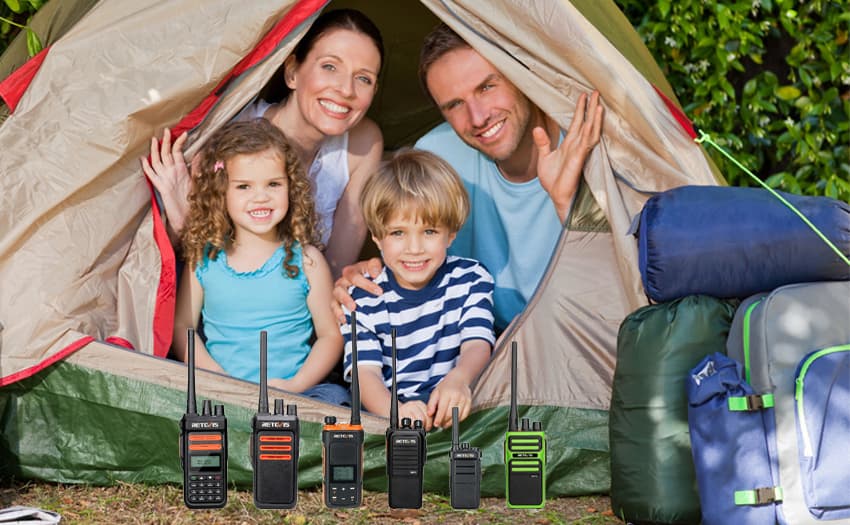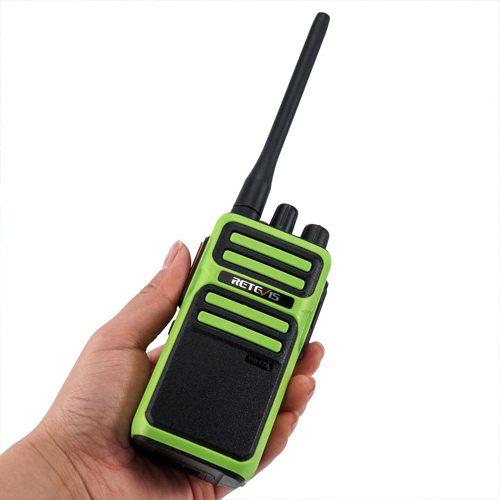Camping strategy: How To Choose The Right Walkie-Talkie?
- Retevis Solutions
- GMRS walkie talkie, camping walkie talkie, camping radio, NOAA walkie talkie, waterproof GMRS radio

A walkie-talkie (two-way radio) is often the only viable alternative to a mobile phone in a range of scenarios. Not only are you able to communicate with a large group of people instantaneously, a walkie-talkie allows you to communicate in places where there is little or no mobile network coverage. For campers, because often face the situation where there is no mobile phone signal, using a two-way radio is the primary and preferred method of communication.
With the arrival of the camping season, more and more people are buying walkie-talkies to prepare for camping. However, in the face of the different functions and characteristics of the walkie-talkies on the market, do you know how to choose the right camping walkie-talkie?
Buying a camping walkie-talkie is more complicated than you initially thought. Many manufacturers provide a large number of two-way radios with different appearances and different functions. This brief introduction will guide you to choose the best walkie-talkie for camping.
Step One: Environment – Remote and clean mountain or national park?
The use environment of the walkie-talkie is a key variable in deciding the choice. For example, if you need to use two-way broadcasting in a popular park camping, because of the large number of participants, it is not recommended to use FRS exemption walkie-talkies because it will cause great signal interference. Similarly, if you want to camp in a relatively secluded mountainous area or remote area and use a two-way radio, then you may want to consider buying a walkie-talkie with an alarm function and a good battery.
Step Two: Radio Type-GMRS Or FRS?
It is important to understand the type of radio you need. At present, the two most popular radio types used in camping are FRS and GMRS. The advantage of FRS is that it is license free, but the shortcomings of short distance are also obvious, and the signal interference is serious. The advantage of GMRS lies in its long distance and diverse functions, but GMRS is a license radio, and requires payment (please click on the blog to learn more about GMRS). Therefore, if it is a short-distance outdoor camping communication, you can choose the FRS type; If it is a family camping, it is best to choose GMRS, because GMRS will bring you an advanced radio experience.
Step Three: Distance and Range – How does it affect my Choice?
Most manufacturers will advertise according to the ideal use environment of the walkie-talkie, that is, the ideal distance without obstacles at all, but you must understand the talk distance of the walkie-talkie in the real use environment. For example, FRS walkie-talkies, the usual talk distance is 2.0KM, and 5W handheld GMRS walkie-talkies usually have a talking distance of 3.0km. Therefore, there is a significant difference between the advertising scope of two-way broadcasting and the actual scope. There are many factors that affect the range of the walkie-talkie. These factors include radio interference from other users, cars, camps, and buildings.
Step Four: Power – How much do I need?
The general rule of thumb for effective talk distance and power of walkie-talkies is that every 1 watt of power = 1KM coverage. The higher the power, the greater the range. However, a radio with a general power of 5 watts can only reach a range of about 3 km. This is caused by many factors, such as obstacles in the calling environment, weather, and other reasons. In addition, the power state of the walkie-talkie usually also affects the call distance. A walkie-talkie with sufficient battery charge will reach a longer call distance than a walkie-talkie with a low battery charge. For camping, if you are just an ordinary radio user, not an amateur radio enthusiast, and no special license, when the camping activity range exceeds 2.0km, it is recommended that you choose a walkie-talkie with power above 2W, such as a 3W GMRS walkie-talkie. Or a 5W GMRS walkie-talkie, because the GMRS walkie-talkie allows you to connect to the relay, you can use the GMRS relay to reach a greater distance.
Step Five: License– Yes Or No?
In general, the frequency for which a license needs to be purchased has the least external interference and compared to a license-free walkie-talkie, more functions are allowed. For camping, if it is family camping, there is no more suitable choice than GMRS walkie-talkies. Although the law requires you to purchase a radio license from the FCC, the license costs $35 for a period of 10 years, but all your family members can use it legally and are not restricted by age.
Our camping walkie talkie recommendations:
Welcome to choose the best camping walkie talkie from Retevis Solutions, if you need any help, welcome to contact us: info@retevis.com












